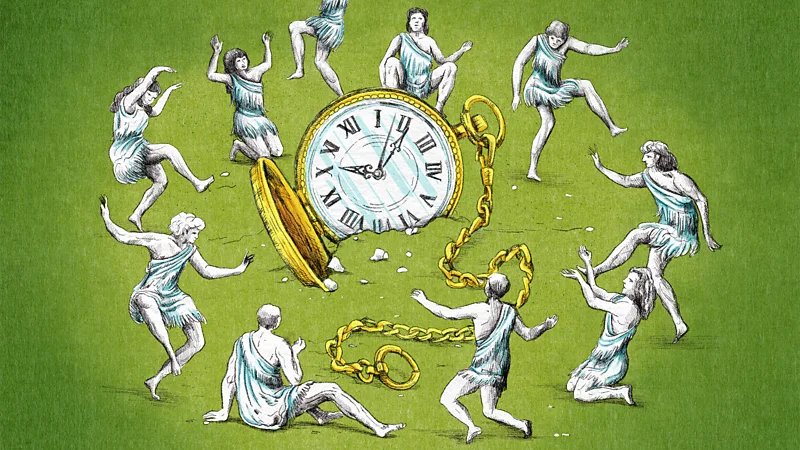A Steady Heart: A Cardiologist’s Advice for Lowering Stress.

By Dr. Jonathan Fisher
A calm, steady mindset doesn’t just protect against stress, it also supports our heart health, writes cardiologist Dr. Jonathan Fisher. In this first Mindful excerpt from Dr. Fisher’s new book, Just One Heart, we learn some of his recommended strategies for cultivating steadiness.
“Dr. Fisher, we need help. A woman was just rolled into the emergency room having runs of V-tach. She’s a healthy fifty-six-year-old woman with no past medical problems…”
Introductions like these always get my attention. There’s a heightened sense of urgency when the heart does something wholly unexpected and potentially life-threatening. I glanced at the medical chart and saw the problem right away. Her heart was racing at three times the normal speed, in a rhythm called ventricular tachycardia (VT), and in a way that caused her to feel like she was going to pass out.
In such moments, I appreciate how remarkably steady a normal heart rhythm is. Beating one hundred thousand times daily and rarely missing a beat, the healthy human heart exemplifies calmness, consistency, and predictability. These are also core features of influential leaders and healers, which allow others to feel calm. On the contrary, an unsteady heart might beat at an average rate one minute, too fast the next, and too slow after that, throwing the entire body out of balance and into distress.
Making matters worse, I knew that her specific heart rhythm abnormality was particularly sensitive to her level of emotional stress. Her rhythm became more unsteady as she worried about her condition, creating a vicious cycle. A critical part of her treatment was to work to reduce her mental and emotional stress to calm her heart. Fortunately, by adding a warm, soothing presence amid an emergency along with the right combination of medications, our team stabilized her heart rate and returned her rhythm to normal.
Moments like this show how connected our thoughts, feelings, sensations, and heart health are.
Just as the physical heart has mechanisms to keep steady and adapt to circumstances, the emotional heart has a similar ability. Still, this ability can become overwhelmed, leading to agitation, chronic stress, and lasting harm.
Can We Change Our Stress Response?
Let’s begin by defining “stress,” which many of us use to describe the uncomfortable feelings of distress, frustration, anxiety, or being overwhelmed. Stress arises when we perceive a gap between the demands of a situation (commonly referred to as “stressors”) and the resources we have to meet those demands. While it’s essential to understand this definition, it’s equally important to acknowledge that only some have the same level of control over their stressors. Individuals facing chronic physical or mental illness, economic vulnerability, or experiences of abuse may encounter stressors that go beyond what can be addressed solely through personal strategies.
From the viewpoint of physics, physical stress is a quantifiable force, and its impact depends on the properties of the object it acts upon, much like how individuals respond differently to the same stress. In psychology, this parallels the concept of psychological “distress,” which arises when we perceive a mismatch between our challenges and our belief in our ability to cope with them. This understanding underscores the importance of recognizing that our perceptions fundamentally shape our internal response to stress.
By reframing our experience as a “stress reaction,” we acknowledge that its roots are internal, influenced by our characteristics and mindset. This perspective is vital for developing effective stress management strategies, especially for those encountering significant life challenges. This parallel between the physical and psychological responses to stress highlights the importance of individual factors in how stress is experienced and managed.
While avoidance might seem the easiest way to deal with stress, it can lead to increased fear and avoidance behaviors in the long run. Instead, cultivate openness and curiosity to face challenges more calmly and realistically. Embrace the chance for personal growth and insights that each challenging situation can offer.
On the path to stress mastery, we must acknowledge that our minds tend to exaggerate risks and bias toward predicting catastrophes, a tendency known as the “negativity bias.” These cognitive tendencies determine how we perceive and respond to stressors, impacting our overall experience of stress.
Ultimately, our ability to handle stress often depends on our capacity to control our attention and create accurate and helpful mental narratives about how we approach challenges.
Additionally, our ability to pay sustained attention and accurately appraise situations can be unreliable due to the overwhelming amount of information we encounter daily and a natural narrowing of our attention during challenges. Understanding these mental processes is fundamental because they influence how we interpret and react to stressors.
Despite these natural cognitive biases, we can improve our stress management skills by enhancing our attention and perception skills. With practice, we can learn to see situations more clearly and experience less distress. Ultimately, our ability to handle stress often depends on our capacity to control our attention and create accurate and helpful mental narratives about how we approach challenges.
Embrace Diastole to Give Your Heart a Break
Every healthy heart has two critical phases: squeezing (systole) and relaxation (diastole). While the squeezing gets much attention, the relaxation phase allows the heart to fill with blood, preparing it for the next beat. Problems with diastole can be as severe as those with systole, potentially leading to conditions like heart failure. Importantly, diastole isn’t passive; it actively consumes energy to ensure optimal filling. Similarly, in our daily lives, periods of active relaxation are as essential as times of work and activity. For optimal mental and physical health, we need these “emotional diastoles.” Just as the heart needs to alternate between systole and diastole, we must oscillate between periods of effort and relaxation to maintain balance.
However, our fast-paced society overlooks—and actively discourages—the human need for slowing down. A heart condition called “tachycardia-induced cardiomyopathy” illustrates the dangers of this pervasive attitude, especially prevalent in the workplace. This condition, caused by the heart consistently beating too fast, leads to a weakened heart, often on the brink of failure. Similarly, sustained high-intensity activity without adequate rest results in decreased efficiency and potential burnout, manifesting as physical and mental health issues like chronic fatigue, anxiety, depression, diminished cognitive function, and poor judgment.
Take, for example, Rosa, a dedicated corporate lawyer. She prided herself on her ability to churn out work around the clock. But over time, the constant pace took a toll on her health, impacting her blood pressure, heart rate, and energy levels. Only when a vacation forced her to slow down did she realize how much she needed regular breaks, her form of diastole, to recharge and perform at her best.
Or consider Jordan, a schoolteacher. Always eager to go the extra mile, he’d stay late to help students, often missing breaks. One day, he fainted from dehydration and exhaustion. My advice? Just as he advises pupils to rest between exercises, he, too, needs moments of diastole in his routine.
During my early medical training, I was not taught the importance of rest and recovery. We received the opposite message from many of our supervising doctors, that rest was a sign of weakness. Our schedules left little time for recovery. I also felt the social pressure to be constantly and consistently active, which is common in the medical field and our “always-on” society.
Around that time, our program director observed my restlessness and unease during less busy periods. He wisely advised me to learn to “enjoy diastole!” It was a lesson in understanding that rest isn’t just the absence of work. It’s an active, necessary, and vital process for recharging.
It was a lesson in understanding that rest isn’t just the absence of work. It’s an active, necessary, and vital process for recharging.
Recognizing the signs that our bodies and minds need to slow down is essential. It might be persistent fatigue, irritability, decreased focus, or feeling overwhelmed. These are signals, much like the symptoms of a heart working too hard, that we need to take a step back and allow ourselves time to recover.
Prioritizing slow, restful periods in our schedules is not a luxury; it’s necessary to maintain our long-term health and well-being. Just as a heart needs time to rest and refill, our minds and bodies need time to rejuvenate. This approach to life prevents the adverse effects of constant high-intensity living and enhances our productivity and creativity when we are active. Let’s commit to prioritizing diastolic moments in our lives. Whether taking a walk in the park, reading a book, or simply sitting in a quiet room and breathing deeply, these “emotional diastole” moments restore us.
A Calm Heart When It Matters Most
As I watched the Netflix documentary series Lenox Hill, I found myself captivated by the life of Dr. David Langer, the chair of neurosurgery at Lenox Hill Hospital in the heart of New York City. It was remarkable how he navigated the immense stress accompanying his demanding role, especially during the peak of the COVID-19 pandemic in 2020. His ability to maintain composure and lead his team under such pressure left a lasting impression on me, prompting me to arrange an interview.
I spoke with Dr. Langer, and he offered valuable insights into the challenges he faces as a neurosurgeon dealing with life-and-death situations daily. He painted a vivid picture of what stress looks like in his world. It’s the weight of knowing that the decisions he makes on the operating table can change a patient’s life forever. It’s the relentless hours spent in the operating room, the constant pressure to perform flawlessly, and the emotional toll of dealing with patients and their families during some of their most vulnerable moments.
Dr. Langer shared that in these high-stress, high-stakes situations, he and his team rely on a set of strategies to maintain their focus and composure. These techniques include mindfulness, self-awareness, preparation for potential setbacks, positive self-talk, collaboration, empathy, and drawing inspiration from the timeless principles of Stoicism. What struck me was that these tactics aren’t exclusive to neurosurgery. They hold significant value in various aspects of life.
Our discussion prompted me to reflect on how our beliefs about stress shape how we deal with it. Exploring the thoughts and emotions that typically arise during challenging situations helps effectively manage stress. Understanding your emotional responses is essential. Additionally, pay attention to the physical signs of stress, like tension in your forehead or faster breathing. Awareness of these emotional and physical stress signals is essential for improving stress management.
8 Whole-Hearted Strategies for Managing Stress
Before we delve into mastering stress, let’s begin with some self-reflection. This process can help you better understand stress and how you perceive it. Take a moment to consider your relationship with stress:
Do you see it as a formidable challenge or a motivating force in your life?
How do you handle everyday stressors? Which coping strategies work best for you?
With these reflections as a foundation, we can now explore practical strategies for mastering stress:
Change Your Environment: Create a soothing and stress-free atmosphere by minimizing exposure to stress triggers. For example, go from a cluttered, noisy workspace to a clean, quiet one.
Shift Your Focus: Learn to redirect your attention away from stressors, effectively modifying your emotional response. Shift your focus from a stressful news story to a calming activity like reading a book.
Reassess Challenges: Gain a balanced perspective on the difficulties you face, moving from seeing a task as impossible to viewing it as a series of manageable steps.
Rethink Beliefs: Adjust your perception of the significance of external events, for instance, going from viewing all work emails as urgent to recognizing that some can wait.
Reframe Thoughts: Change the way you view how stressors impact your life, such as seeing a busy schedule not as overwhelming but as an opportunity to prioritize. Cognitive Behavioral Therapy (CBT) is one technique for rethinking beliefs and reframing thoughts.
Boost Confidence: Recall past successes in managing stress to enhance self-assurance, remembering how you successfully navigated a previous stressful situation at work.
Hone Your Skills: Work on improving your abilities to tackle challenges effectively, evolving from a novice in time management to a proficient planner.
Employ Stress-Relief Techniques: Utilize mindfulness, breathwork, visualization, and thought reframing during stressful times, transitioning from feeling overwhelmed to a state of calmness.
As you engage in these reflections and skills, you’ll develop a more resilient and controlled approach to handling stress, ultimately empowering you to navigate life’s challenges with greater ease and confidence.























































